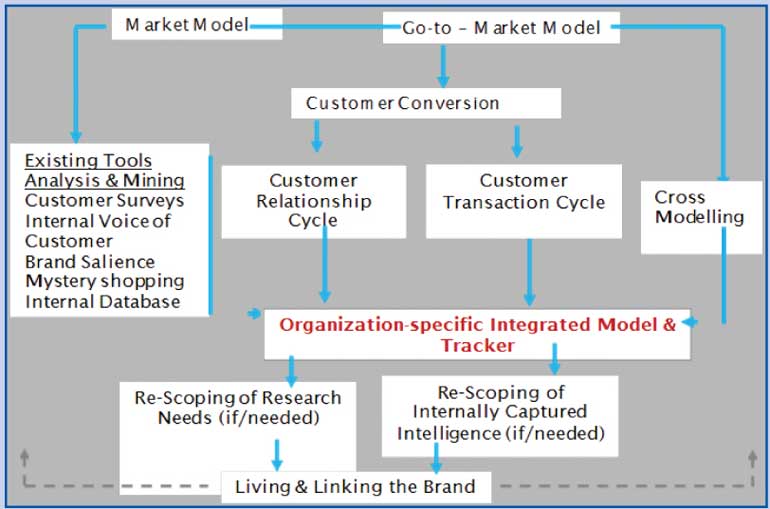Thursday Jan 01, 2026
Thursday Jan 01, 2026
Tuesday, 30 August 2016 00:02 - - {{hitsCtrl.values.hits}}
The symptoms that traditional market research is facing its inevitable death is already evident. With shortening attention spans, increase in tech savvy yet time poor individuals and issues pertaining to receiving feedback from customers would suggest that the  tendency to move towards online tools and platforms is more likely. Thus, in order to survive in an unknown territory the role of the researcher will have to be redefined.
tendency to move towards online tools and platforms is more likely. Thus, in order to survive in an unknown territory the role of the researcher will have to be redefined.
While developing insightful consumer research will continue to be the focal point , the role of the researcher will shift from a passive collector of information/data to an active researcher who forms a comprehensive understanding of the customer from data collected from different range of sources (i.e. through online and offline platforms)
The fact that we are currently living in the digital era is old news. However, the interesting question that one should ask is whether industries and companies today have kept pace with the technological revolution. The availability of computer assisted research tools at the tip of your fingers have threatened the existence of traditional research methods like survey designs. While certain online tools and platforms are in the development stage, there is no doubt that such research tools will pose a considerable threat to traditional research professionals in the future.
The data speaks for itself! Internet penetration in Sri Lanka, as of June 2016 was 27.4%. Nearly ¼ of local population connected online, marketers, advertisers as well as corporations can no longer ignore the digital revolution. In addition to this total Facebook users in Sri Lanka as of February 2016 was 3 to 3.5 Million (Source – Internet World Stats).
Most of the internet visits in Sri Lanka happen through the mobile (68%) so it should be noted that this industry is mobile bias By comparison, the internet penetration in the Middle East, as of November 2015 was 52.2%. What is more alarming is that the internet penetration in the Middle East is higher than the world average! (46.4%).
The growing use of internet and social platforms would suggest that the data trails we leave could be captured and analysed with ease on a real time basis. Thus, without a shred of doubt it is clear that we are moving into an era where behaviours, attitudes, lifestyles and values, can be captured by information systems, rather than through traditional research methods like surveys.
To make matters worse for traditional researchers, offline platforms like wearable technology and virtual reality are changing the game completely. Virtual reality platforms for instance would enable marketers and other business professionals to truly understand the customers by “putting oneself in the other person’s shoes.” Thus, creating the emotion of empathy that researchers so desire to practice and inculcate. Thus, why would corporates rely on traditional research companies, if free DIY (Do it yourself) tools are already available in the market!

Apart from DIY online surveys and digital focus groups, new disciplines in market research like Social Listening, Click Stream and Behavioural Data analytics now gives insights into what consumers are doing, how are they researching the product? Which features/value proposition appeals more? Why do they like a product or brand?
A couple of decades ago when supermarket scanner data was made available – marketers came to know about the basket consumers were buying, the frequency of purchase, coupon redemption, etc. But today due to technological advancements in online tracking (including location and device tracking, eye tracking, set-top box/internet TV/video consumption/internet search tracking) and availability of behavioural data, Marketers with the help of Data Scientists are using advanced modelling to analyse data to provide Predictive Insights (rather than rear-view mirror snapshots) and automate changes to their consumer communication and sales efforts on the fly!
As the old adage goes “if you can’t beat them, then join them!” Thus, it is time that market researchers get on to the bandwagon of digital disruption before it is too late!
The current status
While each of the above components provide useful information/insights, the potential synergies of linking these have not been optimised
It also runs the risk of sub-optimisation, overlaps, working in silos and an inward-looking approach
If strategically linked, powerful synergies could emerge, the organisation can develop a highly-customised model that will help manage and control the brand
Any exercise of this nature is multi-disciplinary, therefore the need to understand the current organisational structure and drivers
Any exercise of this nature requires active involvement of all the different stakeholders
The integrated approach
